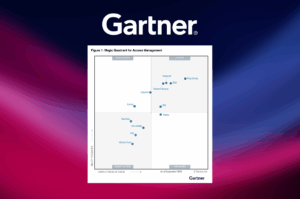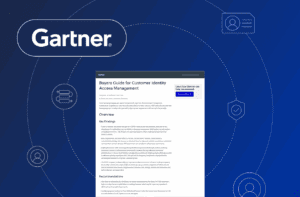As cyber threats such as account takeover, new account fraud and credential-based attacks continue to increase, companies must be proactive in consolidating their identity and security vendors to ensure effective cybersecurity. Consolidating vendors allows for a context-aware, identity-first security posture that supports continuous policy assessment and zero trust.
In the first post in this series, we reviewed the pain points, use cases and business drivers for consolidating vendors. This post will continue that discussion with a guide to help cybersecurity decision-makers plan their vendor consolidation strategy, from assessing consolidation needs to implementing ongoing updates to adapt to evolving threats, new regulations and other changing business needs.
Assess your consolidation needs
Assessing your consolidation needs is the first step towards consolidating your vendors. Start by choosing a platform that natively integrates essential components for risk assessment and controls throughout the identity lifecycle to prevent identity silos that can negatively impact cybersecurity.
These essential components include:
- ID proofing and data validation to gain the highest level of assurance during registration and comply with regulations like Know Your Customer (KYC) without added friction.
- Passwordless, single-sign on (SSO) and multi-factor authentication (MFA) capabilities for strong authentication and compliance with PSD2.
- Identity management for onboarding with fine-grained access controls and a centralized and scalable user store for securely storing and managing users’ personally identifying information.
- Detection and response services for risk, trust, fraud, bots, and behavior recommendations at risk moments throughout the user journey.
- Orchestration services for real-time execution of end-to-end identity security controls.
Develop an action plan for vendor consolidation
After assessing your consolidation needs, you should develop an action plan for vendor consolidation. Start by choosing an identity security vendor to partner with that enables a centralized implementation of decisioning policies and orchestration of complex user journeys across different channels, applications and business lines.
After tailoring controls to your specific business needs, you should plan for ongoing updates that facilitate collaboration across identity, security and fraud teams and enable quickly updating user journeys to meet changing business needs.
Look for the right identity security vendor
Choosing the right vendor to help with consolidation can be difficult for enterprises, who often need to connect to numerous third-party services and databases to execute complex user journeys and implement data-driven decision-making. Vendors that require complex integrations may lead to vendor lock-in and identity silos that can add to, rather than reduce, blind spots and vulnerabilities.
To prevent this, choose an identity security vendor that can provide:
- User journey mapping for developing and implementing risk assessment and controls throughout the identity lifecycle.
- Data mapping and normalization for consistent policy enforcement and data protection.
- User journey controls for managing risk and controlling access to sensitive data.
- Event-level policy definitions for policy enforcement and response to security events.
- Simplified integration changes with the ability to instantly adapt application journeys as needed
- Management for vendor relationships, dependencies, and integrations.
Develop centralized decisioning policies
One of the key drivers of vendor sprawl in customer identity and access management is the difficulty of centralizing decisioning policies for risk, trust, fraud, bots and behavior, which often requires stitching together numerous telemetry streams to create a signal risk signal that delivers actionable insights on handling risk moments.
A do-it-yourself approach based on heuristic rule sets can be difficult to tune and requires long cycles for development and updating, whereas machine-learning based risk engines are often black boxes that do not provide adequate insights on the reasons for recommendations. As a result, businesses often resort to blunt controls applied across entire user bases, rather than tailoring user journeys to respond to context and risk in individual requests. This contributes to added friction, which may result in higher attrition rates or fewer registrations.
When planning decisioning policies, identity controls should not be one-size-fits-all, but rather tailored to user and application-specific risk signals in order to minimize friction for trusted users while blocking or challenging suspicious requests. These policies should enable a seamless user experience while maintaining strong security that continuously assesses risks throughout the user journey.
Orchestrate user journeys
Using actionable risk insights from a centralized risk engine, enterprises can orchestrate user journeys that enable a smooth and frictionless experience for their users.
Enterprise orchestration of identity security should allow for complex journeys and sub-journeys that can respond to risk and trust signals in real time, collect data only as needed and gather identity data on user events with rich metrics and analytics to continuously monitor and assess usage patterns and quickly detect anomalies.
Plan for ongoing updates
Ultimately, the fast pace of changing regulations and emerging threats requires swift adaption to ensure ongoing compliance and security. Whether decisioning logic is implemented via heuristic rules or machine-learning algorithms, rules will quickly go stale, requiring agility in responding to new business requirements, rather than long development, testing and deployment cycles that leave teams struggling to keep up with evolving needs.
Develop a plan for ongoing updates to decisioning mechanisms that do not require significant changes to your application and have enough transparency to be understood by different teams. In addition, no-code and low-code updates that can be made without significant work from engineering teams can expedite changes and allow fraud analysts and security teams to tune and update business logic as needed.
How does Transmit Security enable vendor consolidation?
Transmit Security enables vendor consolidation through a platform of natively integrated, modular services for end-to-end identity security and optimized CX that provides easy access to a full suite of pre-configured identity services — including the only platform-native identity verification service on the market.
This integrated platform enables a centralized, event-based view of how customers are interacting with applications to orchestrate, manage and monitor controls across the Transmit Security platform and any third-party service or database, across the user lifecycle:
- Identity Verification and Data Validation Services provide secure registration and seamless onboarding that complies with Know-Your-Customer (KYC) and other industry regulations.
- Authentication Services enable single sign-on across business lines, risk-and-context based multi-factor authentication and FIDO-based, non-phishable passwordless credentials.
- Identity Management Services let enterprises implement role-based access control with user management via an event-based, highly scalable user store that provides a centralized view of user events across business lines and channels.
- Detection and Response Services that are natively integrated into Authentication and Identity Verification Services combine numerous detection methods and stream logs to third-party services in order to automatically generate transparent, machine-learning based risk recommendations within the context of specific moments of the user journey, skipping the need to configure actions and fetch recommendations.
- Orchestration and Identity Decisioning Services simplify development of real-time action triggers and updates to decisioning logic with no-code and low-code deployment of complex user journeys.
Transmit Security invented the concept of Identity Orchestration and leads the market with services that are used by 8 of the top 10 global banks and proven to scale to more than 100 million users per deployment.
To learn more about consolidating vendors with Transmit Security, check out our interview at Gartner IAM with TIAA’s Director of Digital Identity Services Gaurav Kothari on how TIAA used Transmit Security to consolidate vendors, or read our case study on how a leading US bank used Detection and Response to save millions in operational costs by consolidating their legacy security vendors.



